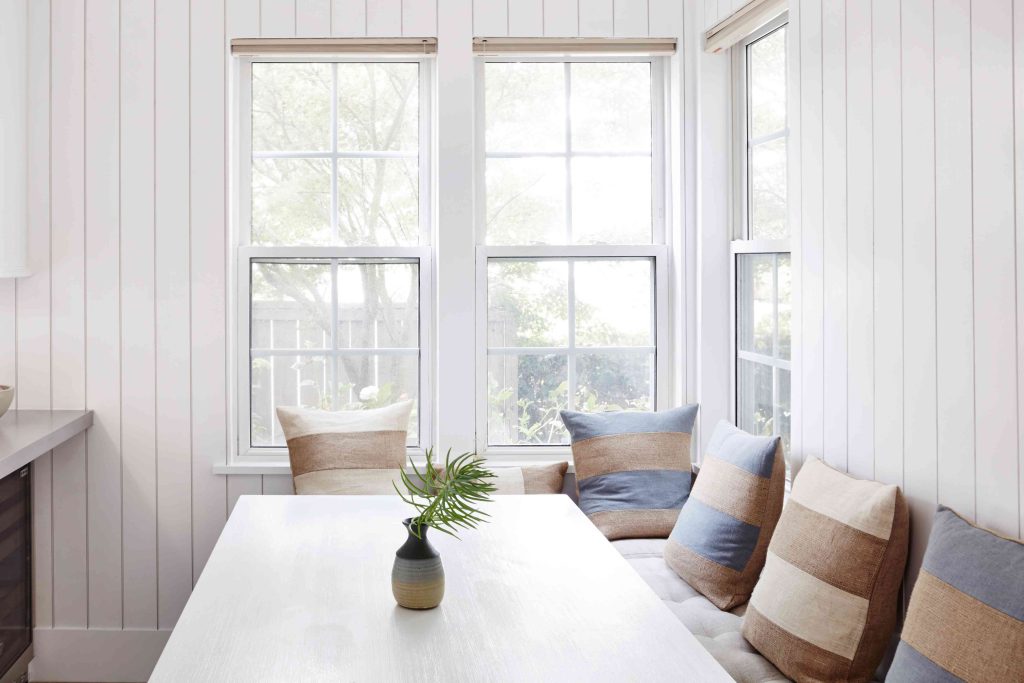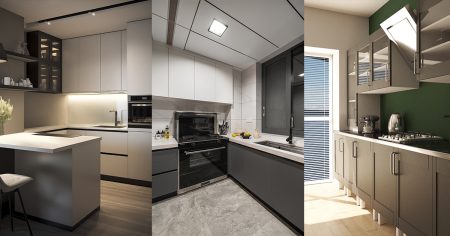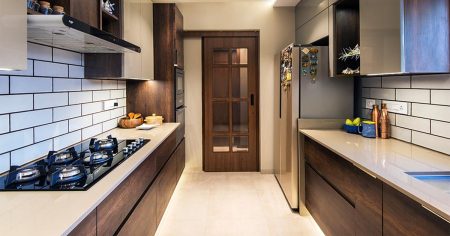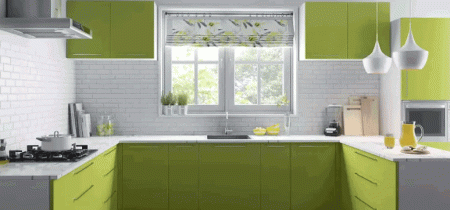Build a DIY breakfast nook and you’ll be able to enjoy coffee, breakfast, and light meals with friends and family—while tucked away in a corner of your kitchen or dining area. Breakfast nook ideas include everything from a small corner bench with a bistro-style breakfast table to a larger picnic-style table with an L-shaped bench and multiple chairs.
This cute, cozy L-shaped nook is assembled from two connecting benches. It’s the perfect place for socializing or for a quiet moment. This easy DIY breakfast nook bench and table is easy to build. It’s a simple design and it does not have a back, but it uses accessible materials found at your local home center, and can be completed in just a couple of days.
DIY Breakfast Nook Features
- Uses Veneer Wood: The bench fronts are faced with plywood, itself faced with hardwood veneer applied in the factory. All you need to do is cut and install the plywood—the veneering has already been done for you.
- Simple: All of the materials can be purchased at your local home center or lumber yard. The structure is made from two-by-fours and the edges are trimmed in one-by-fours.
- Inexpensive: Since the rear sides of the benches face walls, they do not need to be covered with veneer wood. Eliminating this step saves on costs and time.
- Custom Cushions: The cushions can be upholstered in any fabric that you choose.
- Standard Sizing: Nooks come in all sizes with various types of seating and tables but the overall space can range from around 5 feet by 5 feet (for two people) up to 10 feet by 8 feet for a family of four to six, for example.
Scheduling Your Project
While the nook’s build takes only a few hours, you’ll need to factor in the multiple coats of stain and coating. Due to oil-based polyurethane’s slow curing time, this will take two or three days. Be sure that each coat is completely cured before applying the next coat.
What You’ll Need
Equipment / Tools
- Wood glue
- Sandpaper
- 3-inch screws
- 1-1/4-inch screws
- 1-inch screws
- Wood clamps
- Cordless drill
- Electric nailer
- Framing square
- Table saw
- Electric miter saw
- Hand saw
- Staple gun
- Tape measure
- Pencil
Materials
- 8 two-by-fours
- 2 one-by-fours
- 2 veneer finished plywood sheets, 4-foot by 8-foot
- Foam rubber
- Polyester upholstery batting
- Fabric (for cushions)
- Wood stain
- Polyurethane coating, oil-based spray
Instructions
How To Build a DIY Breakfast Nook
-
Cut the Bench Tops and Bottoms
Cut the two-by-fours into eight sections, each 5 feet long. From the remainders, cut eight pieces of two-by-fours, each 18 inches long.
-
Build the Bench Tops and Bottoms
Assemble the cut two-by-fours into four rectangles: the 5-foot pieces forming the two long sides of the rectangle and the 18-inch pieces forming the sides. Screw these together.
-
Build the Bench Vertical Supports
Cut more of the two-by-fours into eight pieces, each 18 inches long. With screws, attach these to the inner part of the two rectangles. By this point, each bench should have a rectangle on the bottom as the base, four inner vertical 18-inch supports, and another rectangle at the top that is flush with the tops of the vertical supports.
-
Face the Benches with Plywood
Cut two pieces of plywood at 5 foot by 18 inches each. Cut two more pieces at 18 inches by 18 inches. Nail the long pieces to the fronts of the frames built in the previous step. Nail the two side pieces to the left of one bench and the right of the other bench.
-
Attach the Benches
Position the benches in an L-shape. From the inside, screw the benches together with the 3-inch screws.
-
Trim the Bench Corners
Because the two outer corners of the benches are rough plywood, they need to be finished. Cut four pieces of one-by-four, each 18 inches long. Wrap each corner with two pieces, nailing them in place.
-
Make the Seat Cushions
Cut a piece of plywood sized according to the top dimension of one of the benches. Cut foam rubber to size. Cut the polyester upholstery batting to fit the top, plus enough extra to extend over the sides and another 2 inches. Use the batting as a template to cut the cushion cloth.
Wrap the foam rubber with the batting and staple it on the bottom. Wrap all of this with the cushion cloth and staple it at the bottom once again. Repeat for the second bench.
-
Cut and Assemble the Table Top
On the table saw, cut a sheet of veneer plywood in half into two pieces, each piece 4-foot by 4-foot. Smear wood glue over the faces with the rough veneer finish, then sandwich them together and attach them to one side with 1-inch screws.
-
Build the Table Column
At a 45-degree miter angle, cut four pieces of plywood 30 inches long by 12 inches wide. Assemble the pieces to form the column for the table. Glue all edges and nail together.
-
Build the Table Base
Similar to the tabletop, cut two pieces of plywood at 24 inches square each. Glue them together and screw on one side.
-
Assemble the Table
Locate the center of the tabletop (bottom) and the table base (top). Build two brackets from two-by-fours. The size of each bracket should be based on the inner dimension of the table column. Screw these brackets to the bottom of the tabletop and the top of the base. Slide the column over each bracket and screw or nail from the side.
-
Add Table Top Banding
Cut four pieces of one-by-four wood to fit around the perimeter of the tabletop. Cut each end at a 45-edged angle. Glue and nail to the sides of the tabletop.
-
Stain and Protect the Breakfast Nook
Stain or paint the bench and table, then apply a polyurethane coating to protect both items.
Warning
Oil-based polyurethane coating is noxious and should not be sprayed indoors. Move the items outdoors if you wish to use this coating.
To avoid moving the banquette and table, use a water-based polyurethane coating in quart size and brush it on (it has very little odor).
Tips For Building a DIY Breakfast Nook
- Select the veneer wood carefully for the best wood grain.
- Note that veneered wood usually has one side of fine-quality veneer and an opposite side of lower-quality veneer wood.
- When placing the veneer wood on the benches, make sure that the two endcap pieces display the best grain because they are the most visible.
-
Are breakfast nooks outdated?
Although breakfast nooks are a concept that took hold in American homes in the 1920s, they can still be a popular home feature in new home construction where they’re updated and expanded, often as an alternative to larger formal dining spaces. In addition, many home furnishings retailers sell modern breakfast nook sets.
-
Do breakfast nooks add value to your home?
A breakfast nook could add resale value to your home if it’s well-designed, is cozy but not cramped, and doesn’t eat into storage space.
-
Does a breakfast nook save space?
A breakfast nook with built-in bench seating can add functionality to your kitchen while saving space. Built-in benches condense the footprint of your eating area leaving more space for storage or traffic circulation. However, if you already have an island and other eating areas but you need more storage, the space could be better put to use with a pantry or extra cabinetry.
Read the full article here














